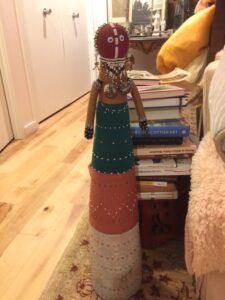 JE owns a tall, three and a half foot, fabric and beadwork Zulu doll her father collected in South Africa in the 1960s. He worked on a project that took him to Zululand. JE uses this doll with a weighted base for a door stop. She wonders if it’s worth something. Yes! Not only that, it’s a great example of a mature female doll. Notice those two round breasts.
JE owns a tall, three and a half foot, fabric and beadwork Zulu doll her father collected in South Africa in the 1960s. He worked on a project that took him to Zululand. JE uses this doll with a weighted base for a door stop. She wonders if it’s worth something. Yes! Not only that, it’s a great example of a mature female doll. Notice those two round breasts.
I place it as made by the Zulu peoples of South Africa, who descended from the Nguni Peoples of Southeast Africa. I’m definite about that because I actually saw dollmakers of Zululand at work when I visited South Africa in 2005.
When my son studied at Duke University, they sent him over on a collaborative program with the University of the Witwatersrand. He was based in the Kruger National Reserve. I visited him and visited my old South African college friend from Zimbabwe. When we left my son at the Kruger, my friend and I toured the 10,0000 square miles of the Zululand reserve along the Indian Ocean.
When JE sent in this photo, I recognized it as a Zulu female doll. How elegant she looks. I love the way the face is portrayed with a line down the middle, emphasizing the forehead central area and the nose.
Zululand Dolls and Rituals
For centuries humans have used dolls as playthings. Perhaps more importantly we associate dolls with burial rituals, marriage rituals, and fertility rituals. Let me provide context with a contemporary cultural doll ritual. Think of a wedding cake. We place two dolls on the very top. Those are OUR marriage dolls.
Fertility dolls have the most desirable baby-making genetic potential. Think of the Barbie doll. Because male fertility is not often displayed in American culture, we have only one representation, the female fertility figure of a grown voluptuous woman. Not so in African culture where fertility dolls are both male and female.
The dollmaking tradition in Zululand goes back to the 14th century. The artists of the doll, female, start with a frame of wood. In the case of JE’s doll, the wood frame has a base weight. They shaped the wood into a female profile, a long, elegant shape of the hourglass form. Or a fertility form, rotund and pregnant, or a young female form.
Notice that JE’s has breasts and long earrings signaling the adult female. Most Zulu dolls are narrow waisted, and tall and lean.
Zululand’s many markets impressed me when I visited South Africa. They sold such dolls and the wonderful, beaded necklaces, and the electrical (colored) wire baskets, an invention of the 20th century in fine art. Such color! I mostly remember the yellow and red of those tiny beads worked into meticulous patterns.
Previous to this artistry of dolls, baskets, and jewelry created by the female artists, Zulu arts focused on military needs. Fierce Zulu warriors made shields (often Zebra hide), spears, and clubs.
JE’s doll has colored beads, strung by hand on a rope, and worn as a necklace. Also, we see everything is handmade including the fabric on the clothing, and the twine embroidery around the doll. Some dolls come with caps of the auspicious cowrie shells, used in early days for money. All have beadwork, and some beadwork hairstyles.
Zulu Blanket Doll
A subset of the Zulu doll is the Zulu blanket doll. Traditionally a bride’s new parents in-law gave her a bride doll in her likeness. A blanket-cape, the wedding attire of tradition, and a golden circular necklace, also traditional, and a beadwork apron of five panels, representing the bride’s father’s gift of five head of cattle as dowry. This doll also wore a wedding veil, symbolizing the division between herself as a maiden and herself as a wife.
I’ve seen similar Zulu dolls to JE’s, but none so tall. So I put the value at $600. Of course, because of its age, if sold at auction, it may sell for close to $1,000.
Thank you Elizabeth for such background material. Fascinating!